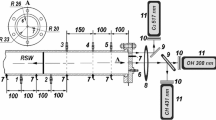Summary
-
1.
The hot-body ignition temperatures under free convection conditions and the dependence of TS on composition were measured for air mxtures of hydrogen, acetylene, carbon disulfide, ethylene glycol ethyl ether, and diethyl ether.
-
2.
It was established that ignition can occur at TS to 180°C which is incompatible with a thermal mechanism. Low-temperature ignition is explained by the formation of cold flames associated with the development of degenerate branching of the chain-reaction process. A reaction of sufficient duration for this occurs only under conditions of free convection.
-
3.
In many cases TS is evidently affected by a two-stage mechanism; in this case the minimum TS may correspond to compositions close to the critical compositons for flame propagation.
-
4.
The results of the investigation confirm the need for a reexamination of existing safety regulations. Permissible temperatures should be determined under hot-body ignition conditions corresponding to the actual use of equipment when cold-flame ignition is a possibilitv.
-
5.
The following permissible temperatures, which incorporate the necessary safety factor, may be recommended: for CS2 and (C2H5)2O−150°, for C2H2−300°, for H2 and ethylene glycol ethyl ether −500°, for B-70 gasoline−700°, and for CH4−800°C.
Similar content being viewed by others
References
Ya. B. Zel'dovich, ZhETF, 9, 1530, 1939.
L. N. Khitrin and S. A. Gol'denberg, DAN SSSR, 103, 277, 1955.
A. I. Rozlovskii, DAN SSSR, 117, 651, 1957.
R. S. Silver, Phil Mag., 23, 156, 633, 1937.
S. Patterson, Phil. Mag., 28, 186, 1, 1939; 30, 203, 437, 1940.
J. U. Muller, J. W. Fenn, and M. R. Irby. III Symposium on Combustion, 231, 1949.
A. I. Rozlovskii, I. S. Roizen, and P. G. Sushchev, Izv. VUZ. Khimiya i khimicheskaya tekhnologiya, 2, 962, 1959.
Rules for the Manufacture of Explosion proof Electrical Equipment [in Russian], Gosenergoizdat, 1963.
A. I. Rozlovskii Vest. tekhn. i ekonom. informatsiya, 9, 33, 1962.
H. F. Coward and P. G. Guest, J. Amer. Chem. Soc., 49, 2479, 1927.
P. F. Kovalev, Explosion proof Electrical Equipment for Mines, Candidates dissertation, Makeevka, 1953.
L. E. Ashmen and A. Büchler. Combustion and Flame 5, 113, 1961.
A. G. Gaydon and H. G. Wolfhard, Flame, Its Structure, Radiation and Temperature [Russian translation], Metallurgizdat, 1959.
E. A. Gel'fand, Tr. NIITB v neftyanoi promyshlennosti, no. 7, 58, 1954.
V. N. Zaichenko and E. A. Gel'fand, Tr. NIITB v neftyanoi promyshlennosti, no. 9, 64, 1956.
B. Kaesche-Kuscher and H. C. Wagner, Brennstoff-Chemie, 39, 33, 1958.
V. Ya. Shtern, Oxidation Mechanism of Hydrocarbons in the Gas Phase [in Russian], Izd-vo AN SSSR, 1960.
K. Spence and D. T. A. Townend. Nature, 155, 330, 1945.
A. I. Rozlovskii and Yu. M. Ribas, Method of Determining Permissible Safe Heating Temperatures of Explosion proof Electrical Equipment and Device for Its Realization, Author's Certificate no. 158433, 5 April 1962.
P. A. Ragozin, Handbook of Aviation and Motor Fuels [in Russian], Gostoptekhizdat, 1947.
A. I. Rozlovskii, Zh. VKhO im. D. I. Mendeleeva, 7, 651, 1962.
V. G. Voronkov and N. N. Semenov, Zh. Fiz. khim., 13, 1695, 1939.
A. L. Myerson and F. R. Taylor, J. Amer. Chem. Soc., 75, 4348, 1953.
A. G. White, J. Chem. Soc., 498, 1927.
M. S. Hsieh and D. R. A. Townend, J. Chem. Soc., 332, 337, 341, 1939.
J. E. C. Topps and D. T. A. Townend, Trans. Farad. Soc, 42, 345 1946.
H. F. Coward and G. W. Jones, Limits of Flammability of Gases and Vapors, U. S. Bureau of Mines, Bull., 503, 1952.
N. P. Drozdov and Ya. B. Zel'dovich, Zh. fiz. khim., 17, 134, 1943.
H. G. Wolfhard, Jet Propulsion, 28, 798, 1958.
H. G. Wolfhard and M. Vanpee, VII Symposium on Combustion, 446, 1959.
Additional information
Fizika Goreniya i Vzryva, Vol. 1, No. 4, pp. 10–19, 1965
Rights and permissions
About this article
Cite this article
Ponizko, T.A., Rozlovskii, A.I. Hot-body ignition limits for air-fuel mixtures. Combust Explos Shock Waves 1, 5–11 (1965). https://doi.org/10.1007/BF00748804
Issue Date:
DOI: https://doi.org/10.1007/BF00748804




